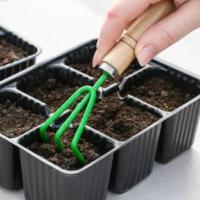Creating Your Planting Areas
by Dan Eskelson on Apr 29, 2012
In the last issue, Down and Dirty - Understanding Your Soil, I discussed basic soil concerns - fertility, drainage, pH...this article will address the "hands-on" processes of creating planting areas.
When I first learned this trade, the accepted advice was to plant shrubs and trees in a hole enriched with organic matter and fertilizer...don't do it! The roots of your plants will love the enriched soil so much that they will circle round and round within the hole, eventually stifling growth. and in clay soil, the relatively dense walls of the hole will hold water in the enriched root zone - the "bathtub" effect.
The far superior method of soil improvement is to enrich the entire planting bed with several inches of organic matter and required fertilizers as described in the last issue. This way, plant roots can spread evenly in all directions, as rain and irrigation deliver nutrients from the enriched topsoil.
Be sure to maintain a slope away from your house...in the first 10 feet of land surrounding your home, the grade should slope approximately 12 inches, then tapering to a 2 percent angle. Maintain the soil around your home so that natural land erosion does not cause the slope to disappear.
In most cases, it's best to create planting beds with a slight crown, or hill, near the middle of the bed and sloping downward toward the edges. This will help to keep roots out of standing water during very wet periods. In very sandy soils, however, level beds are OK. In either case, create a basin around each plant that extends to, or further, than, the drip line; especially important during the first year, this will help to deliver water where it's needed.
When creating your lawn areas, keep in mind that grassroots need at least six inches of good topsoil - and most turf-type grasses need a constant diet of nutrients. So start out with good rich soil to encourage the good establishment and limit additional fertilizer applications.
Mix soil amendments very thoroughly - you'll definitely see streaks of varying green shades if you don't. It may be necessary to run the rototiller or tractor over the area four to six times, each in a different direction.
after thorough mixing, rake the lawn area with steel garden rakes, removing rocks and stones down to about the size of your thumbnail. If your soil is very stony, remove many of the smaller stones too...new seed needs fine soil to adhere to and sprout with healthy growth. This can be a slow, labor-intensive project in some soils.
after the initial raking and rock removal, use wide grading rakes to put a smoother finish on the surface. Rake in several directions to fill low spots and knock down high spots. This often brings up an additional rock to deal with. When you've achieved a fairly level lawn area, use a full lawn roller to pack the soil. Push, or pull, the roller slowly, in at least two directions.
The compaction will bring out more irregularities in the grade. Use the grading rakes again, in several directions, to smooth the grade. Roll again, and rake again, until you're satisfied with the smoothness of the grade.
Popular Articles
Three Places to Spend Money on the Exterior of Your Home
When you have the exterior of your home remodeled, you are investing, time, energy and convenience into the project and you want to make sure that...
95852 Views
Homemade Headboards-Make an Upholstered or Wooden Headboard
Homemade headboards can add a lot of personality to any bedroom. They can be coordinated with existing furniture and room decor or they can be the...
74465 Views
When to Use a Brush, Roller or Sponge Brush
Brushes are a good choice for painting trim and woodwork. They are also useful for cutting in the edges around the top and bottom edges and corners...
71826 Views
Creating a Cottage Kitchen with Bead Board
Kitchen decor can range from modern and bold to elegant and elaborate by using strategic kitchen pieces. One of the most popular decorating trends...
52910 Views
Gas Fireplace Diagnostics and Troubleshooting
Follow these steps for diagnosing and troubleshooting Gas Fireplaces repairs. For the average DIYer, this may seem intimidating, depending on the...
30646 Views
Latest Articles
How Much Does It Cost To Take A Bath?
Plumbers know that a bath may seem like a relaxing luxury, but the real cost extends far beyond your water bill. The average soak uses 35 to 50...
on Apr 8, 2025
10 Concrete Patio Ideas on a Budget
A concrete patio can be a game-changer for your outdoor space. It is durable, versatile, and can be customized to fit your style. But what if you...
on Mar 25, 2025
Tips for Creating a Stunning Personalized Photo on Canvas
Order the unique beauty of a personalized photo on canvas and bring your memories to life. With a customized photo on canvas, you can transform...
on Mar 7, 2025
Best Areas to Buy Property in Singapore for Long-Term Growth
Singapore's real estate market remains one of the most stable and lucrative in the world. With limited land supply, strong governmental...
on Feb 18, 2025
Troubleshooting Excess Water in Your HVAC Secondary Condensate Drain Pan
When maintaining your air conditioning system, it is easy to overlook the condensate drain pan - until excess water starts pooling in places where...
on Jan 12, 2025
Featured Articles
What Type of Licensed Contractor Should You Hire?
on Feb 28, 2017
Hire Contractors / Estimates

Looking for a specialty project? There are many types of contractors available for your home improvement needs. Finding the right type of...
Sponsored Articles
Best Areas to Buy Property in Singapore for Long-Term Growth
on Feb 18, 2025
Real Estate / Finance

Singapore's real estate market remains one of the most stable and lucrative in the world. With limited land supply, strong governmental...
Actions
Top Categories
- Garden / Landscaping / Patio — 264
- Kitchen / Bathrooms — 240
- Real Estate / Finance — 203
- Appliance / Repair — 186
- Interior Design / Decor — 184
- HVAC / Air Conditioning — 148
- Cleaning / Maintenance — 144
- Improvements / Remodeling — 131
- Plumbing / Basements — 118
- Floors / Tile / Hardwood — 116
- Doors / Garages — 113
- Safety / Security — 113
Articles Archive
More DIY Articles
All You Ever Wanted to Know About Landscape Design Professionals
One important aspect of home décor and aesthetics is landscape. You need to possess sound knowledge of design principles, outdoor structural...
The Do's and Don't of Garden Décor
Garden décor is usually an area where people take some chances and exercise a very liberal amount of creativity. Whether it’s because the traffic...
How to Prepare Your Garden for the Winter Months
You have spent months building a BBQ in your garden, enjoying your homemade furniture and admired the carefully selected hanging baskets you chose...
Getting Your Kitchen Lighting Just Right
Lighting plays a major role in the interior design of most homes and one of the most important rooms to get right is the kitchen, being both a...
Safety Tips for Scaffolding Workers
It can be very dangerous to work on a scaffold, particularly if the structure doesn’t comply with the set safety standards. It is vital that...

